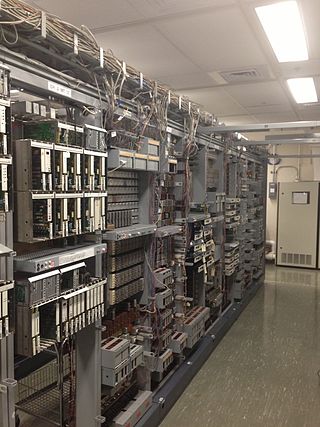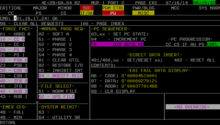
Nokia Bell Labs, originally named Bell Telephone Laboratories (1925–1984), then AT&T Bell Laboratories (1984–1996) and Bell Labs Innovations (1996–2007), is an American industrial research and scientific development company owned by Finnish company Nokia. With headquarters located in Murray Hill, New Jersey, the company operates several laboratories in the United States and around the world.

The 5ESS Switching System is a Class 5 telephone electronic switching system developed by Western Electric for the American Telephone and Telegraph Company (AT&T) and the Bell System in the United States. It came into service in 1982 and the last unit was produced in 2003.
Direct distance dialing (DDD) is a telecommunication service feature in North America by which a caller may, without operator assistance, call any other user outside the local calling area. Direct dialing by subscribers typically requires extra digits to be dialed as prefixes to the directory telephone number of the destination. International Direct Distance Dialing (IDDD) extends the system beyond the geographic boundaries of the North American Numbering Plan (NANP).

A blue box is an electronic device that produces tones used to generate the in-band signaling tones formerly used within the North American long-distance telephone network to send line status and called number information over voice circuits. This allowed an illicit user, referred to as a "phreaker", to place long-distance calls, without using the network's user facilities, that would be billed to another number or dismissed entirely as an incomplete call. A number of similar "color boxes" were also created to control other aspects of the phone network.
The Western Electric Company was an American electrical engineering and manufacturing company officially founded in 1869. A subsidiary of the American Telephone and Telegraph Company for most of its lifespan, it served as the primary equipment manufacturer, supplier, and purchasing agent for the Bell System from 1881 until 1984, when the system was dismantled. The company was responsible for many technological innovations, as well as developments in industrial management.

A voicemail system is a computer-based system that allows users and subscribers to exchange personal voice messages; to select and deliver voice information; and to process transactions relating to individuals, organizations, products, and services, using an ordinary phone. The term is also used more broadly to denote any system of conveying a stored telecommunications voice messages, including using an answering machine. Most cell phone services offer voicemail as a basic feature; many corporate private branch exchanges include versatile internal voice-messaging services, and *98 vertical service code subscription is available to most individual and small business landline subscribers.

The 3B series computers are a line of minicomputers made between the late 1970s and 1993 by AT&T Computer Systems' Western Electric subsidiary, for use with the company's UNIX operating system. The line primarily consists of the models 3B20, 3B5, 3B15, 3B2, and 3B4000. The series is notable for controlling a series of electronic switching systems for telecommunication, for general computing purposes, and for serving as the historical software porting base for commercial UNIX.
The public switched telephone network (PSTN) is the aggregate of the world's telephone networks that are operated by national, regional, or local telephony operators. It provides infrastructure and services for public telecommunication. The network consists of telephone lines, fiber optic cables, microwave transmission links, cellular networks, communications satellites, and undersea telephone cables interconnected by switching centers, such as central offices, network tandems, and international gateways, which allow telephone users to communicate with each other.

The DMS-100 is a member of the Digital Multiplex System (DMS) product line of telephone exchange switches manufactured by Northern Telecom. Designed during the 1970s and released in 1979, it can control 100,000 telephone lines.
AT&T Computer Systems is the generic name for American Telephone & Telegraph's unsuccessful attempt to compete in the computer business. In return for divesting the local Bell Operating Companies, AT&T was allowed to have an unregulated division to sell computer hardware and software. The company made the 3B series computers.
Multi-Environment Real-Time (MERT), later renamed UNIX Real-Time (UNIX-RT), is a hybrid time-sharing and real-time operating system developed in the 1970s at Bell Labs for use in embedded minicomputers. A version named Duplex Multi Environment Real Time (DMERT) was the operating system for the AT&T 3B20D telephone switching minicomputer, designed for high availability; DMERT was later renamed Unix RTR.
The precise tone plan is a signaling specification for the public switched telephone network (PSTN) in North America. It defines the call-progress tones used for indicating the status and progress of telephone calls to subscribers and operators.
Telecom Valley was an area located in Sonoma County, California specifically the Redwood Business Park of Petaluma, California.
A class-4, or tandem, telephone switch is a U.S. telephone company central office telephone exchange used to interconnect local exchange carrier offices for long distance communications in the public switched telephone network.

The Number One Electronic Switching System (1ESS) was the first large-scale stored program control (SPC) telephone exchange or electronic switching system in the Bell System. It was manufactured by Western Electric and first placed into service in Succasunna, New Jersey, in May 1965. The switching fabric was composed of a reed relay matrix controlled by wire spring relays which in turn were controlled by a central processing unit (CPU).
The GTD-5 EAX is the Class 5 telephone switch developed by GTE Automatic Electric Laboratories. This digital central office telephone circuit switching system is used in the former GTE service areas and by many smaller telecommunications service providers.

PSTN network topology is the switching network topology of a telephone network connected to the public switched telephone network (PSTN).

A telephone exchange, telephone switch, or central office is a telecommunications system used in the public switched telephone network (PSTN) or in large enterprises. It interconnects telephone subscriber lines or virtual circuits of digital systems to establish telephone calls between subscribers.








